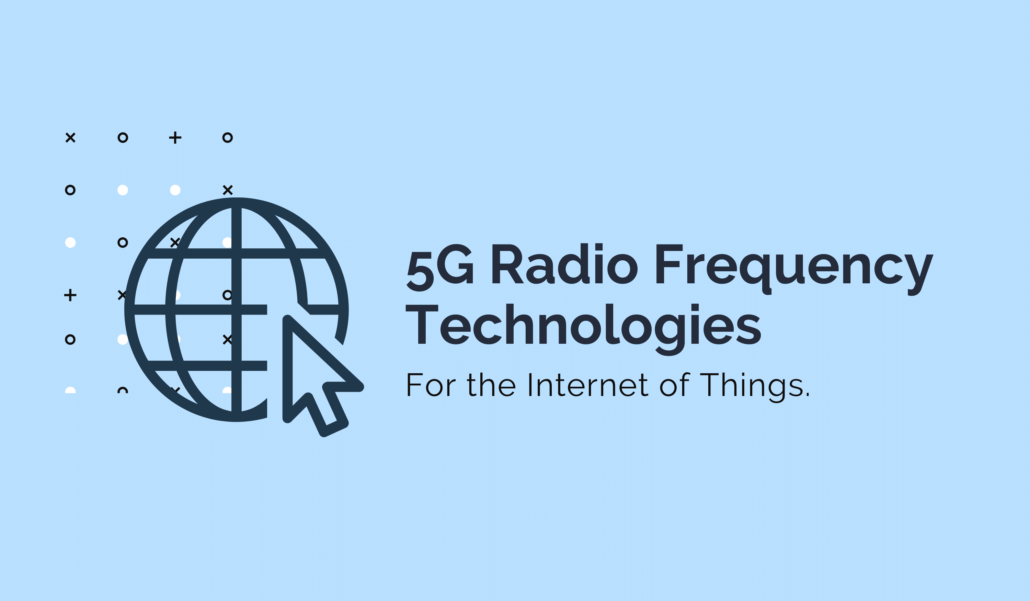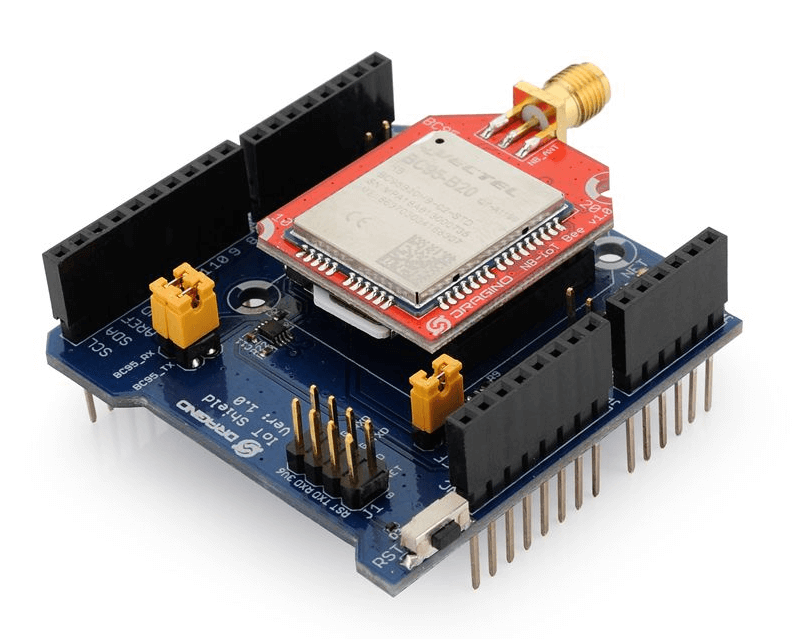5G RF Technologies for the Internet of Things (IoT)
Radio Frequency or RF Technologies lie at the core of the Internet of Things (IoT) and enable the long range, low power characteristics of IoT. With the advent of 5G RF technologies, IoT is transforming for the better – but taking advantage of the latest and greatest may be difficult for some. In this article, I’m going to demystify the various 5G RF technologies for the Internet of Things. Let’s jump right in!
This article will cover:
- What is Radio Frequency in IoT?
- Types of 5G RF in IoT
- 5G RF Use Cases in IoT
- Top RF Product Recommendations for IoT

What is Radio Frequency in IoT?
First of all, it’s worth mentioning that there are a variety of technologies built on RF. When we talk about RF Technologies in IoT, we specifically refer to the use of RF signals which enable wireless data transmission between IoT devices! In fact, RF is what enables the Internet in the Internet of Things. Thus, deciding on the type of RF communication to use in IoT is critical!
Without getting too deep into the technicals, RF signals are produced from an antenna on a transmitting device, and are received by the antenna on the receiving device. The signal is then demodulated on the other end to “decode” the signal into the payload data. Common examples of RF communication include Bluetooth, Wi-Fi, & LR / LoRaWAN.
In addition, the use of RF in IoT is popular and appropriate for a number of reasons:
- Low Power Consumption
- Good Operating Range
- Good Data Transmission Rate
- Penetrates Walls / Does not Require Line of Sight
Transforming IoT with 5G RF
5G stands for the 5th generation mobile network, which is the successor to the 1G, 2G, 3G, and 4G networks of radio communication.
How will 5G RF technologies enhance the way IoT systems work? Well, in many ways! 5G RF enables faster, more reliable and secure wireless transmission that allows us to make leaps and bounds in IoT devices, including smart-vehicles, energy grids and even AI-enabled machines and robots! In the future, 5G RF will enable massive IoT ecosystems serving billions of devices, on a scale like never before.
Three Types of 5G RF in IoT
A key area of confusion may arise when comparing 4G and 5G RF technologies. It’s important to note that despite needing new infrastructure and hardware, 5G is not uniquely distinct from 4G. Let me explain.
At the core of 5G is 5G NR or New Radio, which is the new global standard for a unified wireless air interface. However, it also significantly expands on 4G capabilities through new techniques such as Orthogonal Frequency-Division Multiplexing (OFDM) to reduce interference. At the same time, 5G increases the usage of spectrum resources to use a greater variety of radio frequencies as compared to 4G, to achieve flexibility in various applications.
These applications can be summarised in three major groups:
Enhanced Mobile Broadband
Enhanced mobile broadband in 5G focuses on higher data throughput in high bandwidth applications of up to 20 Gbps. In this case, applications such as consumer video streaming and security video surveillance will benefit. 5G technologies in this class include: Fixed Wireless mmW, Beam Steering, and can also be considered to encompass 4.5G standards like LTE-A.
Low Latency
Low latency applications refer to transmission requirements which do not require a large bandwidth but instead have strict needs for low response times. 5G holds the potential to reduce latencies to as fast as under 1 ms, which is a 10x improvement over 4G standards through Massive MIMO (Multiple Input Multiple Output). Applications that stand to benefit include mission critical IoT devices like industrial safety mechanisms or advanced healthcare systems, but the possibilities are endless!
Massive IoT
The two defining characteristics of Massive IoT are long range and low power. 5G was designed to enable seamless connectivity in devices no matter the scale, and enables data rates and power requirements to be scaled down for use in lean, efficient IoT communications. Examples of 5G standards include CAT.M & NB-IoT, which have been designed to efficiently co-exist with 5G NR to fulfill cellular IoT requirements for the foreseeable future. Read more about CAT.M & NB-IoT in our previous article!
While not technically considered part of the 5G pool of technologies, LR & LoRaWAN are also great alternatives for Massive IoT applications. Capable of handling thousands of connections at long ranges of up to 15km, LR is still perhaps the most cost effective way to handle large scale IoT that do not require high bandwidth.
5G RF Use Cases in IoT
The Internet of Things is developing at an incredible scale, and improved 5G connectivity will only serve as a catalyst to accelerate it to the next level. Here are some examples of IoT use cases which will benefit from 5G RF technologies.
Remote Robotics
With lower latency transmission enabled by 5G RF technologies, remote robotics is no longer a far cry from reality. In healthcare, for example, 5G will enable robotic surgery by providing high quality video streaming and real-time control. On the other hand, remotely operable robots in hazardous industrial settings or disaster zones will make maintenance and rescue operations much safer!
Smart Cities
With traffic lights, street lighting and waste management becoming integrated in IoT, smart cities create a wider, more connected cyber physical environment to live in. This allows data-driven decisions to optimise operations and reduce costs from, for example, the environmental impacts of idle traffic. With 5G as a standard for wireless connectivity across mobile phones, computers and IoT devices, the interconnectivity of smart cities will become more prevalent than ever before!
Agriculture
IoT in agriculture allows for the optimisation agricultural production through precision farming – careful monitoring and control of numerous environmental conditions, such as temperature, light levels, atmospheric composition and water usage. Other agricultural applications may also include asset tracking and smart irrigation, through which massive stretches of farmland can be managed on one centralised platform! High speeds enabled by 5G allow precision farming to take place on a far larger scale than was previously possible, such as monitoring the conditions of individual animals in real time.
Top RF Product Recommendations for IoT
5G infrastructure is still in the midst of being implemented worldwide, but until widespread adoption is in place, the following products will enable you to build effective and powerful IoT solutions that will last for the years to come!
Dragino NB-IoT Shield-B5
The Dragino NB-IoT Shield-B5 is an Arduino expansion board for popular Arduino boards like the Arduino UNO that enables NB-IoT connectivity. With low power consumption and a wide area of coverage, the Dragino NB-IoT Shield-B5 helps you build a wide range of IoT applications with Arduino, including smart metering or facility management services, security or safety systems, and more!

- Supports 850Mhz NB-IoT bands
- Low power consumption
- Wide area of coverage
- AT command controls
- Supports 3.3V and 5V Arduino
- Compatible with All Popular Arduino Boards
To learn more about the Dragino NB-IoT Shield-B5, kindly visit the Seeed Online Store!
SenseCAP Sensor Hub 4G Data Logger
The SenseCAP Sensor Hub 4G Data Logger is an easy to deploy, industrial-grade, 4G cellular sensor hub. It uses the Modbus-RTU RS485 protocol to communicate with multiple sensors, and comes with 4G for remote communication! This SenseCAP Sensor Hub is a great fit for smart city, agriculture and environmental monitoring solutions.
- Connect up to 32 RS485 sensors
- Industrial-grade build quality – robust and stable
- IP66 rated – waterproof and dustproof
- Supports 2G/3G/4G communication and LTE
- Built-in rechargeable battery
To learn more about the SenseCAP Sensor Hub 4G Data Logger, visit the Seeed Online Store!
Wio-E5 Development Kit
As 5G continues to develop, LR will be one of the critical technologies that complement it in the future era of IoT. The Wio-E5 Dev Kit consists of the Wio-E5 Development Board, an antenna, a USB Type C Cable and a 2*AA 3V Battery Holder. The Wio-E5 Dev Board is embedded with the Wio-E5 STM32WLE5JC module with LoRaWAN compatibility on the global frequency band. It also supports various data protocols and interfaces, such as full GPIOs, RS-485 and Grove!
Product Features:
- Ultra-low power consumption and high performance
- Easy testing and rapid prototyping
- Full GPIOs that lead out to rich interfaces, including RS-485, Grove, and etc.
- Global LoRaWAN® and LR frequency plan supported
- Long-distance transmission range to 10km (ideal value in open area)
To learn more about the Wio-E5 Development Kit, visit the Seeed Online Store now!
Summary
RF communication lies at the core of IoT. As we speak, 5G RF technologies in IoT are rapidly emerging to unify high bandwidth, low latency and long range applications, and we can expect to soon see their transformative effects on various industries! In the meantime, existing technologies and protocols such as LR & LoRaWAN are already enabling IoT systems to utilise ultra long range data transmission, albeit at lower bandwidths, so don’t count them out either!
If you are keen to learn more about IoT technologies, the following material may interest you!
- Cellular IoT Solution – What are Cat-M1 and NB-IoT? What is IoT in Telecommunications?
- What is Industrial IoT? [Case Studies]
- Edge AI – What is it and What can it do for Edge IoT?
- Cluster Computing on the Edge – What, Why & How to Get Started
- LR & LoRaWAN: Vertical Solutions for the Real World